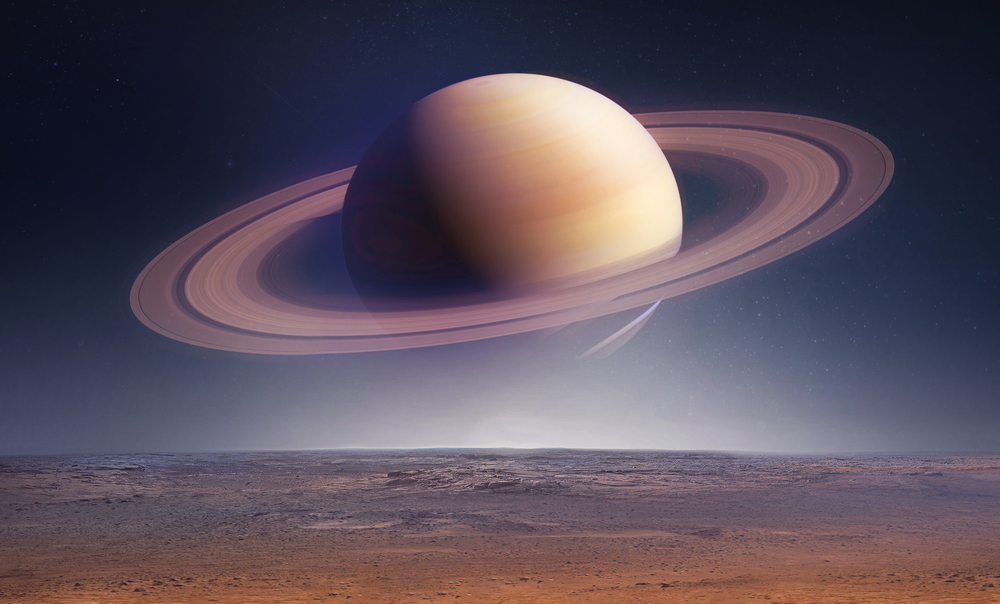From Rings to Moons: 10 Must-Know Facts About Saturn

Welcome to our cosmic exploration of Saturn, a gem of the solar system and a planet that has captivated the imagination of astronomers and enthusiasts alike.
Saturn, the sixth planet from the Sun, is renowned for its stunning rings, making it one of the most visually striking celestial bodies observed through a telescope. These icy rings, shimmering with an array of particles, encircle a world of mystery and wonder.
But Saturn’s allure extends far beyond its iconic rings. The planet is also home to a diverse collection of moons, each with unique characteristics and secrets waiting to be uncovered.
From the methane lakes of Titan to the icy geysers of Enceladus, Saturn’s moons offer a fascinating glimpse into the variety of celestial phenomena within our own solar system.
Join us as we voyage through “From Rings to Moons: 10 Must-Know Facts About Saturn,” an explorative blog post designed to enrich your knowledge and excitement for the wonders of space.
The Rings of Saturn
Fact 1: Composition of the Rings
Diving into the composition of Saturn’s majestic rings unveils a cosmic dance of ice and rock. Predominantly composed of water ice, these rings also harbor dust and rocky debris, painting a picture of space not as a void, but a place of silent, frosty beauty.
Scientists speculate that these rings likely formed from the icy remnants of comets, asteroids, or even moons that shattered under Saturn’s immense gravitational pull.
This celestial ballet of destruction and creation, taking place over millions of years, has bestowed upon Saturn its crown of ice, making it a subject of wonder and study.
The formation of the rings is akin to a time capsule, offering insights into the early solar system’s dynamics and evolution, and reminding us of the constant changes shaping our cosmic neighborhood.
Fact 2: The Colossal Spread
The sheer scale of Saturn‘s rings instills a sense of awe in anyone who contemplates their grandeur. These cosmic adornments stretch out to an astonishing width of up to 282,000 kilometers—that’s approximately the same distance as 22 Earths laid side by side.
Yet, despite this staggering expanse, the rings are remarkably thin, with most sections not rising more than a few meters in height.
This monumental spread, when juxtaposed with the planet itself, showcases the unique aspects of Saturn’s structure. Saturn’s diameter spans about 116,460 kilometers, making the rings appear as a delicate lacework enveloping the gas giant.
This ratio between the rings’ width and the planet’s size underscores the enigmatic beauty and the architectural marvel that is Saturn, setting a scene that looks like it was plucked from the depths of our grandest imaginations.
Fact 3: Visibility from Earth
Observing Saturn’s rings from Earth is an experience that marries the art of patience with the precision of timing. These celestial ornaments are not always visible, but under the right conditions, they offer a spectacular sight through a telescope.
The visibility of Saturn’s rings is influenced by the planet’s position relative to Earth, with the best viewing opportunities occurring when Saturn is at opposition.
This astronomical event happens approximately once a year, when Saturn and the Sun are on directly opposite sides of Earth, allowing the rings to be illuminated in full splendor.
During opposition, Saturn is also closest to Earth, making the rings appear brighter and more detailed to observers. Amateur astronomers and stargazers should also note that the tilt of Saturn’s rings changes over time due to the planet’s orbital dynamics, affecting their visibility.
Every 14 to 15 years, the rings tilt towards Earth at their maximum angle, a phase known as the ring plane crossing, offering a rare and breathtaking view of their majestic expanse.
For those eager to witness this cosmic phenomenon, consulting an astronomical calendar and equipping oneself with a telescope are essential steps in preparing for this awe-inspiring celestial display.
Saturn’s Moons
Fact 4: A Surprising Number
One of the most astounding revelations in the realm of planetary science is the current count of Saturn’s moons. With over 80 known moons, this staggering number not only surpasses that of any other planet in our solar system but also significantly deepens the intrigue surrounding Saturn.
This discovery tells us that Saturn is not just a planetary giant adorned with spectacular rings, but also a celestial haven that hosts a bewildering variety of natural satellites.
This diversity in satellite composition and orbit suggests a complex gravitational dance and a history rich with collisions, captures, and cosmic interactions. Understanding the multitude of moons orbiting Saturn gives scientists invaluable clues about the planet’s formation, evolution, and the dynamic processes playing out in the distant reaches of our solar system.
Such a surprising number underscores Saturn’s role as a focal point of astronomical research and ignites curiosity about what other secrets this enigmatic planet may be hiding.
Fact 5: Titan, The Standout Moon
Titan, Saturn’s largest moon, stands out not only for its size but also for its startling Earth-like qualities, making it a focal point of celestial intrigue and exploration.
This enigmatic moon, larger than the planet Mercury, is shrouded in a thick, nitrogen-rich atmosphere that closely mirrors the pre-biotic Earth, offering scientists a unique window into our own planet’s past.
Its dense atmosphere is laced with organic molecules and hydrocarbon rain, carving rivers and filling seas with liquid methane and ethane, drawing parallels to Earth’s water-based hydrological cycle.
Additionally, Titan’s surface is sculptured by various geological features, from vast dunes to extensive lakes and rivers, showcasing a dynamic and active celestial body.
Such Earth-like conditions, coupled with its complex atmospheric chemistry and potential subsurface ocean, position Titan not just as a point of academic interest, but as a prime candidate in the search for extraterrestrial life and the understanding of planetary evolution across the cosmos.
Fact 6: Enceladus and the Search for Life
Enceladus, Saturn’s icy moon, has captured the imagination of scientists and space enthusiasts alike, positioning itself at the heart of the search for extraterrestrial life within our solar system.
This small yet fascinating world is distinguished by its glistening surface, composed largely of water ice, reflecting sunlight and making it one of the brightest objects in our solar system.
What makes Enceladus particularly intriguing are the giant plumes of water vapor and ice particles that jet out from its south pole, a discovery made by the Cassini spacecraft.
These geysers are believed to originate from a subsurface ocean, lying beneath the moon’s icy crust, hinting at the exciting possibility of liquid water – a vital ingredient for life as we know it.
The composition of these plumes, rich in organic compounds, further fuels the speculation that Enceladus could harbor the conditions suitable for life.
This notion of a habitable environment, hidden beneath an alien ice shell, turns Enceladus into a prime target in humanity’s quest to find life beyond Earth, offering a tantalizing glimpse into the potential for living worlds orbiting distant stars.
Fact 7: Unique Characteristics of Other Moons
Apart from Titan and Enceladus, Saturn’s moon system harbors other celestial bodies with distinctive characteristics, making them subjects of significant scientific interest.
Iapetus stands out with its stark contrasting colors – one hemisphere is as dark as coal, while the other is remarkably bright, suggesting a unique geological history that puzzles astronomers.
This dichotomy in coloration is unlike anything seen on other moons, triggering various theories regarding its origin, including the idea that it could be sweeping up dark material from another moon or the result of internal processes.
Rhea, the second-largest moon of Saturn, boasts its own ring system, making it the only known moon to have such a feature. These faint rings hint at the diverse dynamic processes that satellites can host, challenging our understanding of moon formation and evolution.
Mimas, often nicknamed the “Death Star” moon due to a large crater that resembles the iconic “Star Wars” battle station, showcases the impact history that characterizes many of Saturn’s moons.
These moons, each with its own story, add layers to Saturn’s already complex system, illustrating the diverse geological and atmospheric conditions possible in our solar system.
Saturn’s Position and Movement
Fact 8: Distance from the Sun
Saturn’s majestic presence in our night sky is largely influenced by its orbit and considerable distance from the Sun, which averages about 1.4 billion kilometers (or approximately 9 astronomical units). This vast distance plays a crucial role in how we perceive the ringed planet from our vantage point on Earth.
Despite its enormity, Saturn appears as but a shining dot to the naked eye, with its stunning ring system visible only through a telescope.
The enormity of Saturn’s orbit means it takes approximately 29.5 Earth years to complete a single lap around the Sun, directly impacting its appearance and visibility from Earth through the seasons and years.
The distance also means that sunlight takes over an hour to travel from the Sun to Saturn, diminishing in intensity, which impacts the way we see the planet’s light and coloration.
This distant celestial dance between Earth, Saturn, and the Sun thereby frames our view of one of the most spectacular objects in our night sky, making each glimpse through a telescope a precious moment of cosmic connectivity.
Fact 9: The Length of a Saturnian Year
The length of a Saturnian year is a staggering 29.5 Earth years, a fact that reveals the profound languor with which Saturn traverses its orbit around the Sun. This lengthy orbit results in protracted seasons on Saturn and its moons, each lasting over seven Earth years.
The implications of such extended seasons are especially intriguing when considering the environmental dynamics and potential habitability of Saturn’s moons, such as Titan and Enceladus. On Titan, for instance, these elongated seasons could drastically affect its methanological cycle (akin to Earth’s hydrological cycle but with methane), leading to significant seasonal changes in its atmospheric and surface conditions.
Similarly, the extended periods of darkness and light on Enceladus might influence the geothermal activity believed to fuel its subsurface ocean, thus affecting the moon’s potential as a habitable environment.
This unique temporal rhythm, set against the backdrop of Saturn’s majestic orbit, offers a fascinating glimpse into the complexity of time, climate, and life’s potential across the cosmos.
The Exploration of Saturn
Fact 10: Missions and Discoveries
The exploration of Saturn, its rings, and moons has long been a focal point for space missions, offering profound insights into our solar system’s complexity and beauty.
The pioneering Voyager missions in the late 1970s marked humanity’s first close encounters with Saturn, revealing the intricate structures of its rings and the diverse characteristics of its moons, setting the stage for future exploration.
Yet, it was the Cassini-Huygens mission, a collaboration between NASA, ESA (European Space Agency), and ASI (Italian Space Agency), launched in 1997 and arriving at Saturn in 2004, that revolutionized our understanding of the Saturnian system.
During its epic 13-year sojourn, Cassini provided unprecedented details about Saturn’s atmosphere, the composition and dynamics of its rings, and the geological and atmospheric properties of its moons, including the discovery of the water-ice plumes on Enceladus and the methane lakes on Titan.
Huygens, Cassini’s lander, made history by successfully landing on Titan’s surface in 2005, providing the first direct analysis of the moon’s thick, nitrogen-rich atmosphere and its enigmatic surface.
These missions have not only expanded our knowledge of Saturn but have also fueled speculation about the potential for life in its celestial neighborhood, signifying a monumental leap in the quest to understand our place in the universe.
Conclusion
In wrapping up our cosmic journey “From Rings to Moons: 10 Must-Know Facts About Saturn,” it’s clear that Saturn is not just another planet in our solar system. Its intricate rings, diverse moons, and the mysteries that lie within, from the potential for life on Enceladus to the peculiarities of Iapetus, highlight the complexity and beauty of our cosmic neighborhood.
Studying Saturn and its satellites provides critical insights into the formation and evolution of our solar system, and perhaps into the conditions necessary for life.
We invite you, our curious readers, to continue exploring the wonders of Saturn. Keep an eye on the latest space missions and discoveries, as each new finding peels back another layer of this fascinating planetary system.
The quest to understand Saturn, its rings, and moons is far from over, and the upcoming years promise exciting advances. Whether you’re an amateur astronomer or simply a lover of the stars, the story of Saturn is a compelling chapter in our ongoing exploration of the universe.




